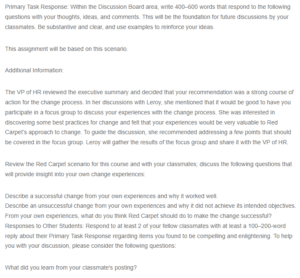Red Carpet – Lessons and Experiences from Successful and Unsuccessful Change
A Successful Change
One of the successful changes that I have observed was changing to remote working during the COVID-19 pandemic. Our organization was among the companies that embraced remote working for all employees during COVID-19 to protect employees from getting infected. The human resource manager sent an internal memo one week before the change was implemented, explaining its need and how it could impact employees. According to Lauer (2020), communicating about a change and its impact on the organization and employees reduces resistance. Communication was vital in helping all employees understand the change and how it would work since most of us had no prior experience working from home. The change worked well because all employees were trained to use Zoom, Google Meetings, and the online employee check-in system before the change was implemented. The change also worked well because the organization asked for employees’ opinions about the change. Employees were also encouraged to suggest improvement areas, thus creating a sense of belonging during the change implementation process.
An Unsuccessful Change
One of the unsuccessful changes I have witnessed was customer service automation. According to König et al. (2020), organizations automate tasks to reduce operating costs. After the COVID-19 pandemic, our organization laid off some employees to reduce operating costs because it had incurred losses due to reduced sales. Customer service tasks were automated as part of the cost-reduction strategy. Unfortunately, the change was unsuccessful because there was a rise in customer complaints since the robots did not offer quality customer service. Customers also raised concerns about the relevance of the information provided by the robots because they were programmed to give a specific response to specific questions. The change also failed because of resistance from employees who felt that accepting automation would put their jobs at risk. The resistance caused delays in implementing the change, and employees were reluctant to provide information that could be used to enhance the change’s success. The change also failed to achieve its intended objectives because customers were not informed how to use the new customer service platform.
What Red Carpet Should Do for a Successful Change
Red Carpet can make its change successful by considering various measures. One of them is engaging all employees in the change implementation process. The company should observe transparency when communicating to employees about the change and collect feedback from employees about the change to increase employee engagement and support. The second measure the company should take is motivating employees to encourage them to accept the change. The company should use benefits and incentives to reward employees who embrace the change and contribute ideas to improve it. The third measure is to help the employees adjust to the change by mentoring and coaching them. Red Carpet may also offer training to equip employees with the knowledge and skills needed to successfully implement the change. The fourth measure is setting key performance indicators to monitor the change and identify threats that could impact its success. Key performance indicators are also essential in identifying improvement areas. The fifth measure is involving employees in making decisions during the change implementation process. Employees may be engaged in decision-making through their representatives to prevent delays in the decision-making process. Red Carpet should also consider benchmarking in organizations that have implemented a similar change to determine what should be done to ensure the change is successful.
References
König, M., Bein, L., Nikaj, A., & Weske, M. (2020). Integrating robotic process automation into business process management. Lecture Notes in Business Information Processing, 132–146. https://doi.org/10.1007/978-3-030-58779-6_9
Lauer, T. (2020). Communication as a success factor: Avoiding and overcoming resistance. Change Management, 119–143. https://doi.org/10.1007/978-3-662-62187-5_8
ORDER A PLAGIARISM-FREE PAPER HERE
We’ll write everything from scratch
Question
Primary Task Response: Within the Discussion Board area, write 400–600 words that respond to the following questions with your thoughts, ideas, and comments. This will be the foundation for future discussions by your classmates. Be substantive and clear, and use examples to reinforce your ideas.

Red Carpet – Lessons and Experiences from Successful and Unsuccessful Change
This assignment will be based on this scenario.
Additional Information:
The VP of HR reviewed the executive summary and decided that your recommendation was a strong course of action for the change process. In her discussions with Leroy, she mentioned that it would be good to have you participate in a focus group to discuss your experiences with the change process. She was interested in discovering some best practices for change and felt that your experiences would be very valuable to Red Carpet’s approach to change. To guide the discussion, she recommended addressing a few points that should be covered in the focus group. Leroy will gather the results of the focus group and share it with the VP of HR.
Review the Red Carpet scenario for this course and with your classmates; discuss the following questions that will provide insight into your own change experiences:
Describe a successful change from your own experiences and why it worked well.
Describe an unsuccessful change from your own experiences and why it did not achieve its intended objectives.
From your own experiences, what do you think Red Carpet should do to make the change successful?
Responses to Other Students: Respond to at least 2 of your fellow classmates with at least a 100–200-word reply about their Primary Task Response regarding items you found to be compelling and enlightening. To help you with your discussion, please consider the following questions:
What did you learn from your classmate’s posting?

